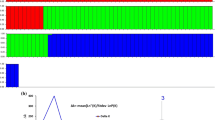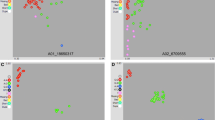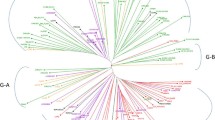Abstract
Accurate assessment of genetic similarity is important for plant breeding, germplasm enhancement and conservation of plant genetic resources. A comparative analysis of genome diversity among a group of six-rowed spring barley (Hordeum vulgare L.) cultivars was carried out using sequence-specific amplified polymorphism (S-SAP) and single nucleotide polymorphism (SNP), with the results compared to the kinship coefficients derived from the pedigree data. Mean pair-wise GS values were estimated to be 0.0957 ± 0.144 (Kinship), 0.491 ± 0.189 (SNPs), and 0.602 ± 0.098 (S-SAPs). S-SAP and SNP-based genetic similarity (GS) values were normally distributed but kinship values had a non-normal and skewed distribution. Pair-wise correlation of GS values were lowest for the S-SAP and the SNP matrices (r =; 0.040, p<0.230) and highest for the SNP and pedigree matrices (r =; 0.240, p < 0.001). Analysis of molecular variance (AMOVA) attributed about 90.4% of observed variation to the cultivars within each of the malting and feed groups. Variance component between malting and feed groups was 6.6% for both SNP and S-SAP data suggesting lack of a significant genetic differentiation along this agronomic division. The remaining 3% of variation was attributed to genetic diversity within cultivars. Although both DNA-based marker systems were able to differentiate all barley cultivars, significant difference were observed in the pattern of genetic relationships obtained by the two marker systems and the pedigree data.
Similar content being viewed by others
References
Autrique E., Miloudi M.N., Monneveux P., Tanksley S.D. and Sorrell M.E. (1996). Genetic diversity in durum wheat based on RFLPs, morphophysiological traits, and coefficient of parentage. Crop Sci. 36: 735–742
Barrett B.A., Kidwell K.K. and Fox P.N. (1998). Comparison of AFLP and pedigree-based genetic diversity assessment methods using wheat cultivars from the Pacific North West. Crop Sci. 38: 1271–1278
Baum B.R., Bailey L.G. and Thompson B.K. (1985). Barley register. Agriculture Canada Publ. 1783B, Ottawa Canada
Bennetzen J.L. (2000). Transposable element contributions to plant genes and genome evolution. Plant Mol. Biol. 42: 251–269
Ching A.D.A., Caldwell K.S., Jung M., Dolan M., Smith O.S., Tingey S., Morgante M. and Rafalski A. (2002). SNP frequency, haplotypes structure and linkage disequilibrium in elite maize inbred lines. MBC Genet. 3: 19 http://www.biomedcentral.com/1471-2156/3/19
Cox T.S., Kiang Y.T., Gorman M.B. and Rodgers D.M. (1985). Relationship between coefficient of parentage and genetic similarity indices in soybean. Crop Sci. 25: 529–532
Cox T.S. and Murphy J.P. (1990). The effects of parental divergence on F2 heterosis in winter wheat crosses. Theor. Appl. Genet. 79: 241–250
Davila J.A., Loarce Y., Ramsay L., Waugh R. and Ferrer E. (1999). Comparison of RAMP and SSR markers for the study of wild barley genetic diversity. Hereditas 131: 5–13
Davila J.A., Sanchez M.P., Loarce Y. and Ferrer E. (1998). The use of random amplified microsatellite polymorphic DNA and coefficient of parentage to determine genetic relationships in barley. Genome 41: 477–486
Dice L.R. (1945). Measures of the amount of ecological association between species. Ecology 26: 297–302
Ellis T.H.N., Poyser S.J., Knox M.R., Vershinin A.V. and Ambrose M.J. (1998). Ty1-copia class retrotransposon insertion site polymorphism for linkage and diversity analysis in pea. Mol. Gen. Genet. 260: 9–19
Graner A., Ludwig W.F. and Melchinger A.E. (1994). Relationships among European barley germplasm. II. Comparison of RFLP and pedigree data. Crop Sci. 34: 1199–1205
Gribbon B.M., Pearce S.R., Kalendar R., Schulman A.H., Paulin L., Jack P., Kumar A. and Flavell A.J. (1999). Phylogeny and transpositional activity of Ty1-copia group retrotransposons in cereal genomes. Mol. Gen. Genet. 261: 883–891
Halushka M.K., Fan J.B., Bently K., Hsie L., Shen N., Weder A., Cooper R., Lipshutz R. and Chakravarti A. (1999). Patterns of single nucleotide polymorphisms in candidate genes for blood pressure homeostasis. Nat. Genet. 22: 239–247
Hirochika H. (1993). Activation of tobacco retrotransposons during tissue culture. EMBO J. 12: 2521–2528
Hirochika H., Sugimoto K., Otsuki Y. and Kanda M. (1996). Retrotransposons of rice involved in mutations induced by tissue culture. Proc. Natl. Acad. Sci. USA 93: 7783–7788
Kalendar R., Grob T., Regina M., Suoniemi A. and Schulman A. (1999). IRAP and REMAP: two new retrotransposon-based DNA fingerprinting techniques. Theor. Appl. Genet. 98: 704–711
Kalendar R., Tanskanen J., Immonen S., Nevo E. and Schulman A. (2000). Genome evolution of wild barley (Hordeum spontaneum) by BARE-1 retrotransposon dynamics in response to sharp microclimatic divergence. Proc. Natl. Acad. Sci. USA 97: 6603–6607
Kankaanpaa J., Mannonen L. and Schulman A.H. (1997). The genome size of Hordeum species show considerable variation. Genome 39: 730–735
Kim H.S. and Ward R.W. (1997). Genetic diversity in Eastern US soft winter wheat (Triticum aestivum L. em. Thell.) based on RFLPs and coefficient of parentage. Theor. Appl. Genet. 94: 472–479
Kleinhofs A., Kilian A., Saghai-Maroof M.A., Biyashev R.M., Hayes P., Chen F.Q., Lapitan N., Fenwick A., Blake T.K., Kanazin V., Ananiev E., Dahleen L., Kudrna D., Bollinger J., Knapp S.J., Liu B., Sorrels M., Heun M., Franckowiak J.D., Hoffman D., Skadsen R. and Steffenson B.J. (1993). A molecularisozyme and morphological map of barley (Hordeum vulgare) genome. Theor. Appl. Genet. 86: 705–712
Langridge P., Karakousis A., Collins N., Kretchmer J. and Manning S. (1995). A consensus linkage map of barley. Mol. Breeding 1: 389–395
Manninen I. and Schulman A. (1993). BARE-1, a copia retroelement in barley (Hordeum vulgare L.). Plant Mol. Biol. 22: 829–846
Mantel N. (1967). The detection of disease clustering and a generalized regression approach. Cancer Res. 27: 209–220
Martin J.M., Blake T.K. and Hockett E.A. (1991). Diversity among North American spring barley cultivars based on coefficient of parentage. Crop Sci. 31: 1131–1137
Nei M. and Li W (1979). Mathematical model for studying genetic variation in terms of restriction endonucleases. Proc. Natl. Acad. Sci. USA 76: 5269–5273
Pearce S.R., Kumar A. and Flavell A.J. (1996). Activation of the Ty1-copia group retrotransposons of potato (Solanum tuberosum) during protoplast isolation. Plant Cell Rep. 15: 949–953
Pejic I., Ajmone-Marsan P., Morgante M., Kozumplick V., Castiglioni P., Taramino G. and Motto M. (1998). Comparative analysis of genetic similarity among maize inbred lines detected by RFLPs, RAPDs, SSRs, and AFLPs. Theor. Appl. Genet. 97: 1248–1255
Powell W., Morgante M., Andre C., Hanafey M., Vogel J., Tingey S. and Rafalski A. (1996). The comparison of RFLPs, RAPDs, AFLPs, and SSR (microsatellite) markers for germplasm analysis. Mol. Breed. 2: 225–238
Queen R.A., Gribbon B.M., James P., Jack P. and Flavell A.J. (2004). Retrotransposon-based molecular markers for linkage and genetic diversity analysis in wheat. Mol. Gen. Genomics 271: 91–97
Rohlf F.J. (2000). NTSYS-pc Numerical taxonomy and multivariate analysis system. Ver. 2.1 Exeter software, Setauket, New York
Russell J.R., Fuller J.D., Macaulay M., Hatz B.G., Jahoor A., Powell W. and Waugh R. (1997). Direct comparison of levels of genetic variation among barley accessions detected by RFLPs, AFLPs, SSRs and RAPDs. Theor. Appl. Genet. 95: 714–722
Saghai-Maroof M.A., Biyashev R.M., Yang G.P., Zhang Q. and Allard R.W. (1994). Extraordinary polymorphic microsatellite DNA in barley: species diversity, chromosomal locations, and population dynamics. Proc. Natl. Acad. Sci. USA 91: 5466–5470
Sanger F., Nicklen S. and Coulson A.R. (1977). DNA sequencing with chain terminating inhibitors. Proc. Natl. Acad. Sci. USA 74: 5463–5467
Schneider S., Kueffer J.M., Roessli D. and Excoffier L. 1997. Arlequin, a software for population genetic data analysis. Ver. 1.1, URL: http://anthropologie.unige.ch/arlequin.
Smith O.S. and Smith J.S.C. (1992). Measurements of genetic diversity among maize inbreds, a comparison of isozymes, RFLP, pedigreeand heterosis data. Maydica 37: 53–63
Smith O.S., Smith J.S.C., Bowen S.L., Tenborg R.A. and Wall S.J. (1990). Similarity among a group of elite maize inbreds as measured by pedigree, F1 heterosis, and RFLPs. Theor Appl. Genet. 80: 833–840
Soleimani V.D., Baum B.R. and Johnson D.A. (2002). AFLP and Pedigree-based genetic diversity estimates in modern cultivars of durum wheat (Triticum turgidum L. subsp. durum (Desf.) Husn.). Theor. Appl. Genet. 104: 350–357
Soleimani V.D., Baum B.R. and Johnson D.A. (2003). Efficient validation of single nucleotide polymorphisms in plants by allele-specific PCR, with an example from barley. Plant Mol. Biol. Rep. 21: 281–288
Soleimani V.D., Baum B.R. and Johnson D.A. (2005). Genetic diversity among barley cultivars assessed by sequence-specific amplification polymorphism. Theor. Appl. Genet. 110: 1290–1300
Souza E. and Sorrells M.E. (1989). Pedigree analysis of North American oat cultivars released from 1951 to 1985. Crop Sci. 29: 595–601
Suoniemi A., Anamthawat-Jonsson K., Arna T. and Schulman A.H. (1996). Retrotransposon BARE-1 is a majordispersed component of barley (Hordeum vulgare L.) genome. Plant Mol. Biol. 30: 1321–1329
Tadeka S., Sugimoto K., Otsuki H. and Hirochika H. (1998). Transpositional activation of the tobacco retrotransposon Tto1 by wounding and methyljasmonate. Plant Mol. Biol. 36: 365–376
Tinker N.A., Fortin M.G. and Mather D.E. (1993). Random amplified polymorphic DNA and pedigree relationships in spring barley. Theor. Appl. Genet. 85: 976–984
Thompson J.D., Higgins D.G. and Gibson T.J. (1994). CLUSTAL W: Improving the sensitivity of progressive multiple alignment through sequence weighting, position-specific gap penalties and weight matrix choice. Nucleic Acids Res. 22: 4673–4680
Tinker N.A. and Mather D.E. (1993). KIN: software for computing kinship coefficients. J. Hered. 84: 238
Vandepoele K., Simillion C. and de Peer Y. (2003). Evidence that rice and other cereals are ancient aneuploids. Plant Cell 15: 2192–2202
Vicient C.M., Sioniemi A., Anamthawat-Jonsson K., Tanslanen J., Beharav A., Nevo E. and Schulman A.H. (1999). Retrotransposon BARE-1 and its role in genome evolution in the genus Hordeum Plant Cell 11: 1769–1784
Waugh R., Mclean K., Flavell A.J., Pearce S.R. and Kumar A. (1997). Genetic distribution of BARE-1-like retrotransposable elements in the barley genome revealed by sequence-specific amplified polymorphism (S-SAP). Mol. Gen. Genet. 253: 687–694
Weir B.S. (1990). Genetic Data analysis Methods for Discrete Genetic Data. Sinauer Associates, Sunderland MA
Wessler S. (1996). Plant retrotransposons: turned on by stress. Curr. Biol. 6: 959–961
Zhu Y.L., Song Q.J., Hyten D.L., Van Tassell C.P., Matukumalli L.K., Grimm D.R., Hyatt S.M., Fickus E.W., Young N.D. and Cregan P.B. (2003). Single nucleotide polymorphisms in soybean. Genetics 163: 1123–1134
Author information
Authors and Affiliations
Corresponding author
Rights and permissions
About this article
Cite this article
Soleimani, V.D., Baum, B.R. & Johnson, D.A. Analysis of Genetic Diversity in Barley Cultivars Reveals Incongruence Between S-SAP, SNP and Pedigree Data. Genet Resour Crop Evol 54, 83–97 (2007). https://doi.org/10.1007/s10722-005-1886-4
Received:
Accepted:
Published:
Issue Date:
DOI: https://doi.org/10.1007/s10722-005-1886-4




